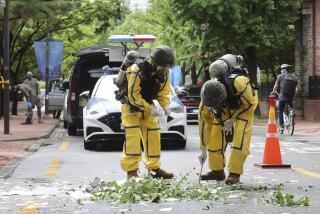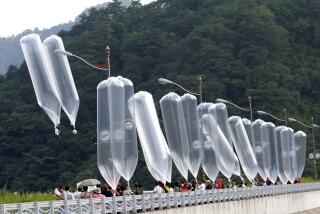Deadly hot-air balloon crash comes amid growing safety concern
- Share via
A 65-year-old Army veteran who had been flying hot-air balloons since college fought to stop his flame-engulfed balloon from crashing on Friday night, said authorities, who found his body and another in the Virginia woods and presumed a third person on board also died.
Virginia State Police did not name the pilot or two passengers, but family and other officials confirmed their identities.
Retired Lt. Col. Daniel Kirk loved flying and traveling, said his father, Donald, by telephone Saturday. The younger Kirk had started flying balloons commercially about a decade ago in Delaware, nicknaming his balloon “Starship” and himself “Captain.”
He was a regular at national ballooning events and had been among more than dozen balloon pilots who came to Doswell, Va., this week for the inaugural Mid-Atlantic Balloon Festival. Thirteen balloons soared into the air for the kickoff event Friday evening.
As Kirk began his twilight descent with two women from the University of Richmond athletics staff, the balloon struck a live power line and the gondola burst into flames. Witnesses recalled hearing screams and an explosion, and seeing possibly two people falling or jumping out of the gondola.
Balloon crashes have killed 114 people in 67 incidents in the United States since 1964, according to a National Transportation Safety Board database. A recent government-funded study of commercial flight crashes from 2000 to 2011 found all five deaths in those cases came after collisions with trees, power lines or buildings.
Last month, the NTSB expressed concern about “the number of recurring accidents” involving similar safety issues. The board recommended that the Federal Aviation Administration treat hot-air balloons carrying paying passengers the same as helicopters and planes by subjecting tour operators to more regulation.
Balloon pilots must be certified and their balloons regularly checked by authorities. But the NTSB said recent studies of accident data showed the current lack of surveillance checks and other oversight contributed to “operational deficiencies” in commercial hot-air balloon flights. Some went up in the air despite risky weather, while others failed to follow the flight manual.
Part of the worry is that balloons can now transport more than 20 people. The NTSB noted that the U.S. hadn’t had a major balloon disaster, but alluded to last year’s high-profile fire on a balloon in Egypt. Nineteen of the 21 people aboard died.
“The NTSB is vitally interested in these recommendations because they are designed to prevent accidents and save lives,” the board wrote to the FAA, asking for a reply by July.
The Balloon Federation of America, a trade association, said last month that the industry’s self-regulation was sufficient and that the FAA was already overburdened with responsibilities.
“The accidents cited by the NTSB were the result of human factors and this recommendation does not address this causal link and therefore will not enhance safety,” the federation stated.
The NTSB and FAA are investigating how the Virginia crash unfolded.
The Virginia State Police said that the balloon pilot struggled to contain the fire and keep the balloon airborne, but it plummeted to the ground in flames.
Debra Ferguson told the Free Lance-Star of Fredericksburg that she saw balloons landing safely in a field near her yard, then saw another balloon in trouble.
“As soon as we looked up, the thing blew up right there,” Ferguson said. “All I heard was, ‘Oh my God, oh my God,’ and all you saw was the top of the balloon still flying, but all of the basket was gone.”
Event planners canceled the balloon festival, citing the tragedy. They had expected as many as 20,000 people to attend at Meadow Event Park in Caroline County, north of Richmond.
The state police said items from the downed balloon were recovered in a heavily wooded area near the intended landing site.
The first body was recovered just before midnight Friday, and the second about 11 a.m. Saturday. The search for the third body was called off for the night Saturday.
A family spokeswoman told the Associated Press that the person still unaccounted for is Natalie Lewis, 24. The class of 2011 graduate had just finished her second season as the director of basketball operations for the University of Richmond women’s team. She twice served as a team captain for Richmond’s swimming program, the university said.
Ginny Doyle, the team’s associate head coach, had posted several photos on Instagram of her and Lewis at the festival. Doyle, 44, was killed in the crash, her sister told the Washington Post.
A former Richmond player, Doyle had worked for the program for 16 years. For 18 years, she held the Division I record for consecutive free throws made, with 66.
The university said they were invaluable and devoted mentors to players, and it canceled baseball games scheduled for the weekend.
“Words cannot begin to express our sorrow,” Athletics Director Keith Gill said in a statement. “We are all stunned by the tragic news. Our thoughts and prayers go out to their loved ones.”
The deadliest accident involving a hot-air balloon in the U.S. killed six people near Aspen Airport in Colorado in 1993, when a sudden change in wind speed and direction shot the balloon into a power line, according to the NTSB. In a flash, the basket cut off from the balloon and crashed. Eleven of the 67 investigated balloon accidents in the U.S. have involved three or more deaths.
After a study released last fall, Johns Hopkins University researchers said that, in addition to the fatal crashes, the number of serious leg injuries suffered by passengers during hard landings was also worrisome. The researchers called on passengers to wear helmets and for gondolas to contain more cushioning and crash-worthy seats.
More to Read
Sign up for Essential California
The most important California stories and recommendations in your inbox every morning.
You may occasionally receive promotional content from the Los Angeles Times.











